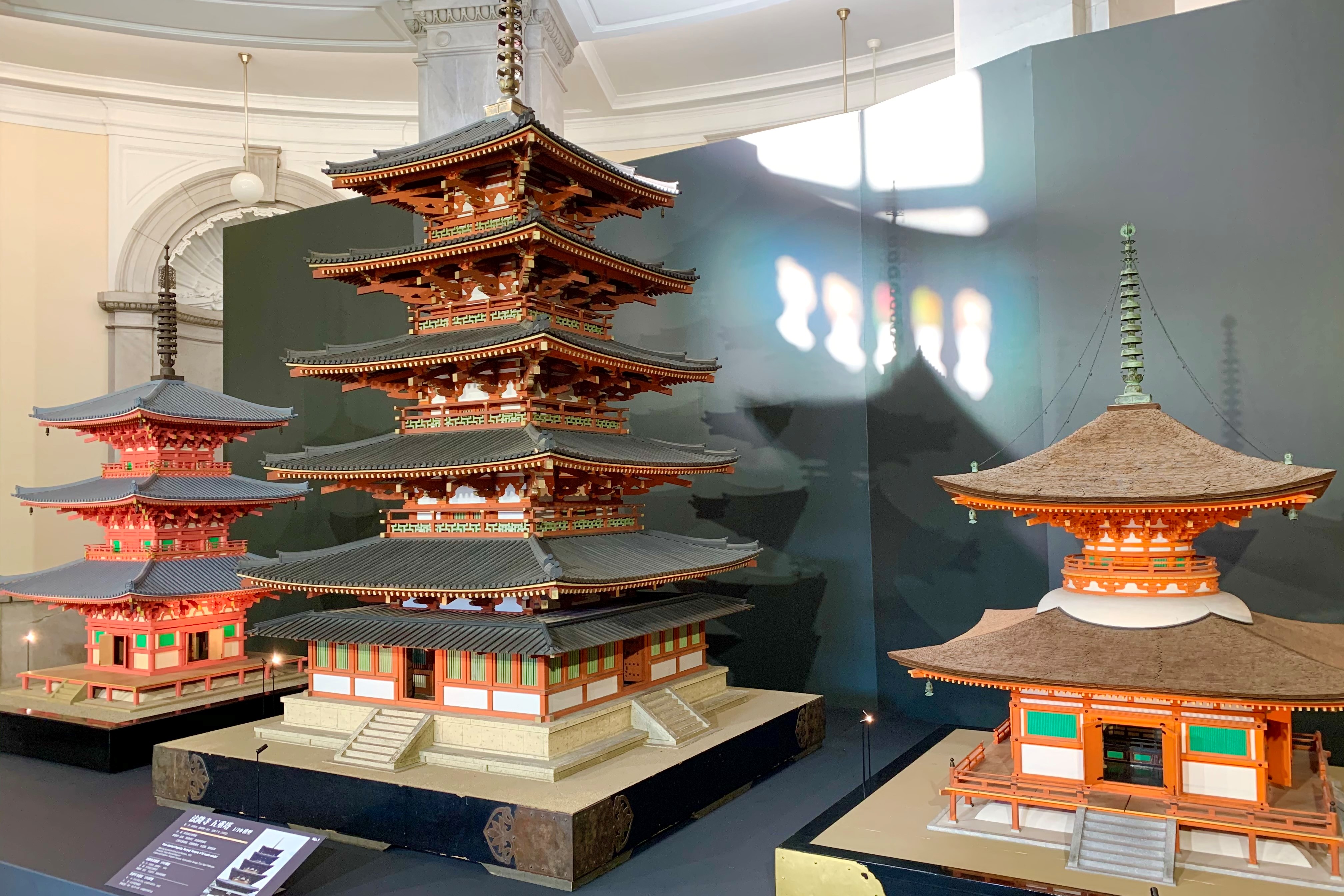
The exhibition "Japanese Tate-Traditional Techniques and Wisdom Utilizing Natural Materials", which introduces the modeling characteristics and craftsmanship of traditional Japanese architecture through materials such as models and designs, is held at the Tokyo National Museum and National Science. It is being held jointly by the museum and the National Archives of Modern Architecture.
This exhibition has different exhibition themes and sessions for each venue.
This time, I saw an exhibition at the Tokyo National Museum on the theme of "Ancient to modern times, the origin of Japanese architecture" that started on December 24th, so I will report on the venue and the exhibited works.
* Tokyo National Museum "From ancient times to modern times, the origin of Japanese architecture"
Date: December 24, 2020-February 21, 2021
* National Science Museum "Modern Japan, Diversification of Styles and Technologies"
Session: December 8, 2020-January 11, 2021
* National Archives of Modern Architecture "Craftsman and Modernization-Inheritance and Development of Carpentry Technology-"
Date: December 10, 2020-February 21, 2021
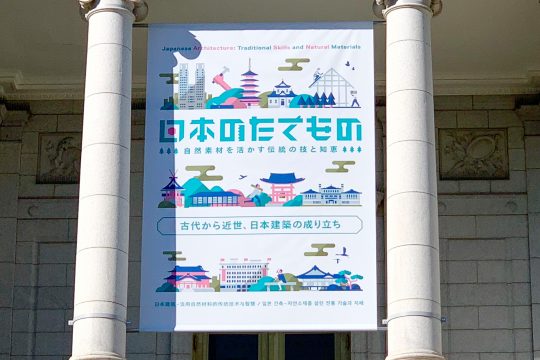

《Todaiji Bell Tower 1/10 Model》 1966, Oda-gumi production / Tokyo National Museum collection / Original building 1207-1211, National treasure
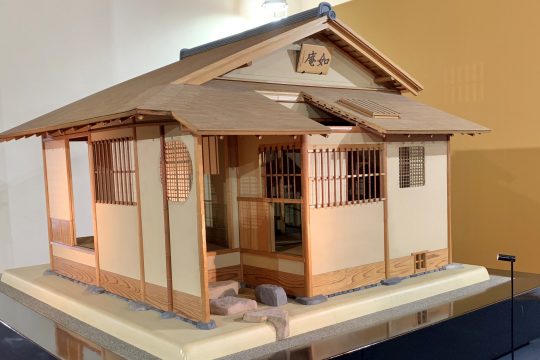
《Nyoan 1/5 Model》 1971 ・ Kyoto Scientific Specimen Production / National Museum of Japanese History / Original Building 1618 ・ National Treasure

《Tofukuji Sanmon 1/10 model》 1979 ・ Daiei Doken Kogyo, Kozo Soda et al./National Museum of Japanese History / Original building 1405 ・ National treasure
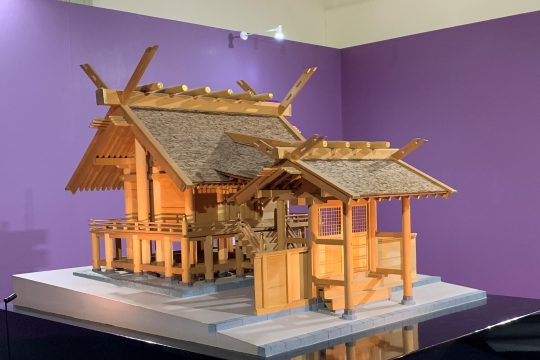
《Nishina Shinmeigu Main Hall 1/10 Model》 1973 ・ Produced by Ito Heizaemon Architects / National Museum of Japanese History / Original Building 17th-18th Century National Treasure
Buddhist temples, castles, tea rooms-A variety of 19 ancient and modern traditional architectural models are on display.
Traditional Japanese architecture has repeatedly changed and diversified while adapting to the climate and region under social conditions such as politics and religion and infusing the aesthetic sense of each era.
The architectural model is a condensed expression of the excellent techniques and aesthetics of the craftsmen found in such traditional architecture. Wood, soil, stone … It can be said that it is a convenient existence to get a bird's-eye view of the history of Japanese architecture itself, as well as the modeling features that make use of various natural materials.
The main exhibits in "From ancient times to the early modern period, the origin of Japanese architecture" are models whose original buildings are national treasures and important cultural properties, such as the Horyuji Five-storied Pagoda, Matsumoto Castle Tower, Tofukuji Sanmon, and Nyoan. With 19 models that have been precisely reproduced in detail, you will appreciate the styles and designs of traditional architecture up to the early modern period.
It is rare for such models to come together, and some of them are architectural models that have rarely been shown before, making it a valuable exhibition.
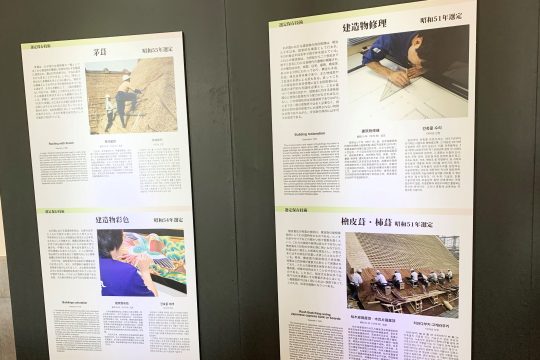
Inside the venue, there is also a polite introduction panel about craftsmen and techniques that inherit traditional architecture.
Great power! Presence of 1/10 scale model
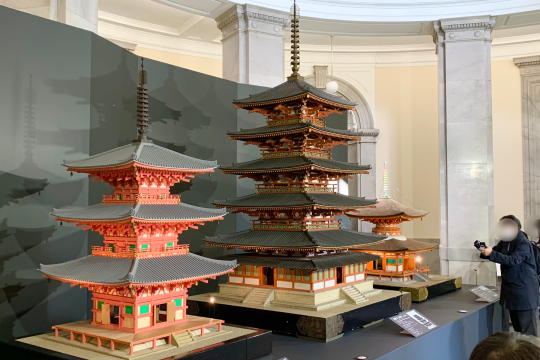
Exhibition view From the left, "Ichijoji three-storied pagoda 1/10 model" "Horyuji five-storied pagoda 1/10 model" "Ishiyamadera Tahoto 1/10 model"
The venue for this exhibition is the Hyokeikan in the Tokyo National Museum. In each room on the 1st and 2nd floors, works were classified into a wide range of categories such as "medieval Buddhist temples," "shrines," and "private houses."
Most of the architectural models on display are 1/10 the size of the original building, which is quite large. It is very powerful and you can carefully check not only the overall structure but also each of the ornaments.
In addition, some models were arranged so that they could be viewed from anywhere around 360 degrees, while others were divided and manufactured so that the internal structure could be confirmed, such as Tofukuji Sanmon and Toshodaiji Kondo.
It is recommended to appreciate the work from various angles, from front to back and diagonally from below.
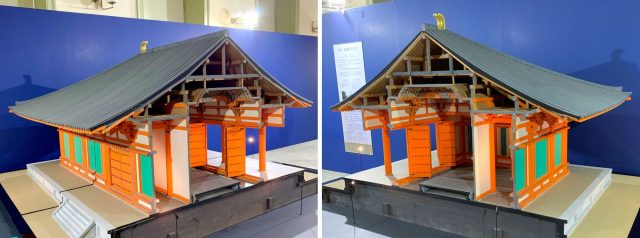
《Toshodaiji Kondo 1/10 Model》 1963 ・ Produced by Ito Heizaemon Architects / Tokyo National Museum Collection / Original Building 8th Century National Treasure
For example, here. The 1/10 model (divided) of Toshodaiji Kondo is actually a beautifully colored pattern that reproduces the original building behind the ceiling. However, I have inadvertently overlooked it and regret it, so if you are going to go, please watch every corner.
The more you look for any model, the more highlights you will find. You may enjoy it like a treasure hunt.
Introducing model works
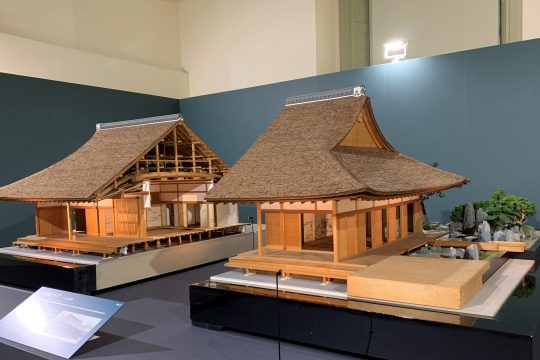
《Daisenin Main Hall 1/10 Model》 1969 ・ Produced by Ito Heizaemon Architects / National Museum of Japanese History / Original Building 1513 ・ National Treasure
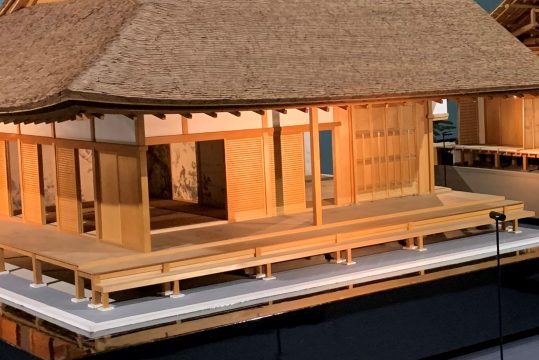
Same as above
The main hall of Daisen-in Temple, which is said to have the oldest "Tokonoma" in Japan, is a representative building of Zen-in Hojo architecture and is designated as a national treasure.
What I would like you to pay attention to in this 1/10 model (divided) is the obstacle painting. It was amazing to see that even one of Motonobu Kano's masterpieces, "Four Seasons Bird-and-Flower", was reproduced in detail.
Currently, it has been renovated to a hanging width, but it was originally an eight-sided fusuma painting. It may be said that the fun of the model is that you can appreciate the Daisen-in Temple at that time when the fusuma paintings were included.
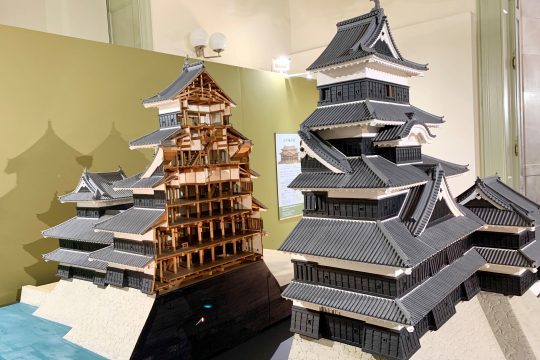
《Matsumoto Castle Tower 1/20 Model》 1963 ・ Produced by Ito Heizaemon Architects / Tokyo National Museum Collection / Original Building 16th Century National Treasure
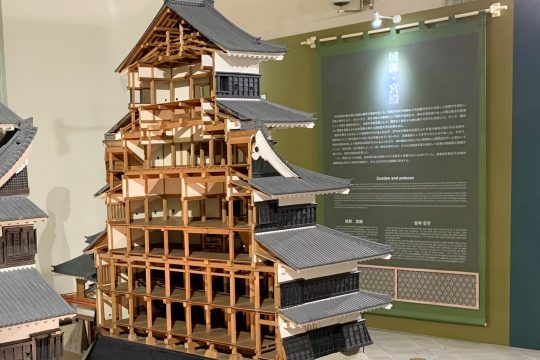
Same as above
Matsumoto Castle, along with Himeji Castle, is the representative remains of the five-storied castle tower, and is said to be the oldest existing five-storied castle tower in Japan. It seems that a model was made as an example of a typical Japanese castle architecture.
This 1/20 model (divided) is also impressive enough. I can't imagine what the inside looks like from the outside, but when I look at the overall structure from the cross section, I noticed various things such as "the arrangement of the stairs is interesting" and "the space itself is quite simple". Feel fresh and exciting.
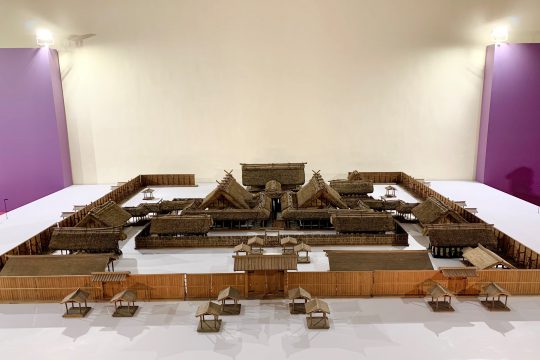
《Model of Meiji Degree Daijomiya》 Meiji era, Shikibu job production / Imperial Household Agency / Original building 1871
In November 2019, following the coronation of the new emperor, the Miyanaka ritual "Daijosai" was held to pray for the well-being and fertility of the five grains for the nation and the people, and was open to the public.
The festival ground "Daijo-sai", which was built just for that purpose, has already been dismantled, but in this exhibition, a model of "Meiji degree Daijo-sai" used at the Daijo-sai, which was the throne of the Emperor Meiji in 1871, is exhibited.
Reiwa's "Daitogu" had a thatched roof, but this was lined with traditional thatched roof buildings.
It was made by the Shikibu staff of the Imperial Household Agency, and was exhibited at the Tokyo National Museum until the Taisho era, but after that it was stored in a warehouse. It's a waste that such a masterpiece has been buried for many years …!
◆ A model of Shurijo Castle, which was burnt down in 2019.
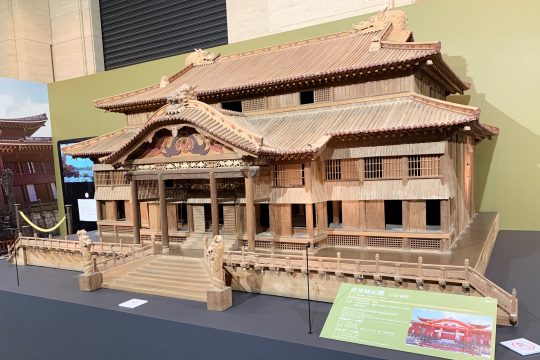
《Shuri Castle Main Hall 1/10 Model》 1953, Chinen Choei Production / Okinawa Prefectural Museum and Art Museum Collection / Original Building First Half of 18th Century (burned down in 1945)
Shurijo Castle, which is said to have been built in the first half of the 18th century, was once the cultural and diplomatic center of the Ryukyu Kingdom and can be called a symbol of the history of Okinawa.
The main facilities were restored in 1992 after the Battle of Okinawa, but a large-scale fire in October 2019 burned down 6 buildings including the main hall. The appearance of the fiery flames burning was covered in the news every day, so I think many people are new to their memory.
A 1/10 model of Shurijo Castle will also be exhibited at this exhibition. This work was made in 1953 by a carpenter named Chinen Choei who participated in the dismantling and repair before the war, and this is the first time that it will be exhibited at an exhibition outside Okinawa Prefecture.
You can see a unique design that mixes Japanese and Chinese architectural styles. For example, the two-story, three-story building and the stairs that spread out from the front are unique to Ryukyu.
Although the characteristic vermilion color of the original building cannot be seen, I was motivated to rebuild it in 2026 by comparing it with the photo of the main hall of the day on the same floor.
On December 17, the United Nations Educational, Scientific and Cultural Organization (UNESCO) summarized the techniques of 17 fields inherited by Japanese palace carpenters and plasterers, "Traditional Building Craftsmanship: Traditional Techniques for Inheriting Wooden Buildings" UNESCO I just decided to register it as an intangible cultural heritage.
That's why now, why not take a look at the techniques and aesthetics that the Japanese have cultivated so far at the "Japanese Tate-Traditional Techniques and Wisdom Utilizing Natural Materials" exhibition.
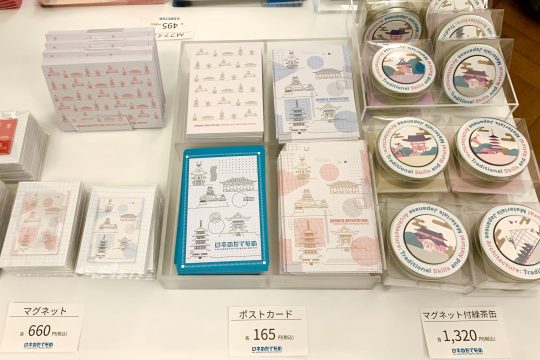

The original design goods were very cute!
Outline of the event
"Japanese Tate-Traditional Techniques and Wisdom Utilizing Natural Materials"
Venue theme "From ancient times to modern times, the origin of Japanese architecture"
| Session | December 24, 2020 (Thursday) -February 21, 2021 (Sunday) |
| Venue | Tokyo National Museum Hyokeikan |
| Opening hours | 9:30 am to 5:00 pm * Open until 9 pm on Fridays and Saturdays * Closed at 5 pm on Saturday, January 2, 8 (Fri), and 9 (Sat) |
| closing day | Monday, December 26, 2020 (Sat) -January 1, 2021 (Friday / holiday), January 12 (Tue) * However, the museum will be open on January 11th (Monday / holiday). |
| Admission fee | General 1,500 yen, university students 1,000 yen, high school students 600 yen * Free for junior high school students and younger, persons with disabilities and one caregiver. |
| Notes | * Admission is by online advance reservation (reserved-seat ticket). * If the capacity is not reached, reception is possible on the day. Click here for tickets ↓ https://tsumugu.yomiuri.co.jp/tatemono/ticket.html |
| Official page | https://tsumugu.yomiuri.co.jp/tatemono/ |


